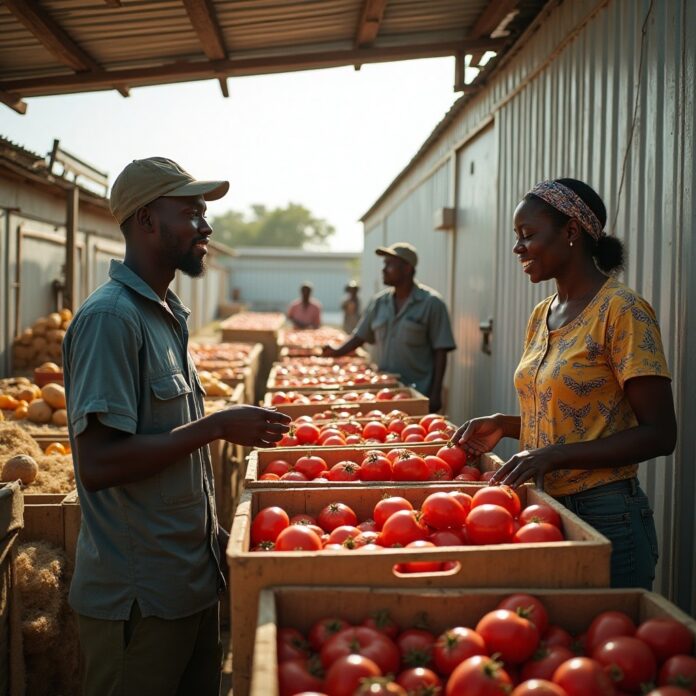You’ve seen it firsthand: baskets of tomatoes rotting in the midday sun, fresh fish turning sour before reaching the market, or yams sprouting prematurely in poorly ventilated rooms. Nigeria’s farmers lose up to 40% of their perishable harvests post-production—a gut-wrenching reality when 80% of the country’s agricultural output comes from smallholders like you. High diesel costs, erratic power, and outdated storage methods aren’t just inconveniences; they’re profit killers. But what if you could slash energy bills by 50% and reduce spoilage to single digits? Let’s cut through the noise. No theories. No fluff. Just actionable steps to turn your cold storage from a money pit into a profit engine.
🏗️ BuildNaija Expo 2025!
🗓️ May 30-31 | Online Event via Google Meet
The State of Cold Storage in Nigerian Agriculture
Let’s be blunt: Nigeria’s cold storage infrastructure is a patchwork of bandaids. You’re stuck choosing between diesel-guzzling generators (₦1,200 per liter and rising) or “cold rooms” that fluctuate between freezer and furnace temperatures. Take tomatoes—Nigeria produces 1.8 million tons annually, yet 45% spoil before sale. Why? Most facilities lack humidity control, and farmers in states like Kaduna and Ogun still rely on open-air sheds with wet jute sacks.
But here’s the kicker: Efficient cold storage isn’t about fancy tech. It’s about smart adaptation. Ghana’s ColdHubs model—solar-powered units that charge farmers ₦100 per crate daily—reduced spoilage by 80%. Rwanda’s Inzovu cold trucks use biogas from crop waste. Nigeria has similar potential. Your maize, fish, or leafy greens don’t need a ₦50 million warehouse. They need consistency: stable temperatures, airtight insulation, and energy sources that don’t hinge on the national grid.
Energy-Saving Techniques for Cold Storage
You’re tired of diesel fumes and NEPA bills that read like ransom notes. Let’s fix this.
Renewable Energy Integration
Solar isn’t a “luxury” anymore—it’s survival. In Kano, Green Energy Africa built a 10-ton solar cold room for ₦7.5 million. It powers 24/7, costs ₦0 in fuel, and pays for itself in 18 months by slashing spoilage. For smaller farms, modular solar units (₦1.2–₦2 million) can chill 2–5 tons of produce. Still skeptical? Compare: Running a diesel generator for 12 hours daily burns ₦432,000 monthly. Solar? Zero.
Biogas is your hidden ace. A Lagos tilapia farmer feeds cassava peels and fish waste into a digester. It powers his cold room and lights his farm. Setup cost: ₦350,000. Monthly diesel savings: ₦180,000.
Energy-Efficient Refrigeration Tech
Inverter compressors (like those from LG or Hisense) use 40% less energy. A ₦480,000 inverter unit cools a 5-ton room for ₦12,000 monthly in electricity—half the cost of old models.
Insulation is where most fail. A yam warehouse in Enugu lined walls with woven bamboo mats (₦8,000 per roll) and sealed gaps with foam from discarded mattresses. Result? Temperatures stayed stable for 72 hours during a blackout. No magic—just ingenuity.
Preventing Spoilage Losses
Let’s talk about your worst enemy: humidity. In Kebbi, Aliyu Musa buries clay pots halfway in his storage shed, fills them with water, and lets evaporation maintain 70% humidity for onions. No electricity. No complex tech.
🏗️ BuildNaija Expo 2025!
🗓️ May 30-31 | Online Event via Google Meet
Inventory Management: The Silent Profit Killer
Adopt FIFO—First In, First Out. Tag every bag with dates and move older stock to the front. Ngozi Okeke in Abia cut spoilage by 65% in six months using this method.
Case Studies: Nigerian Success Stories
Lagos Fish Processor’s Solar Leap
Chidinma Adebayo took a ₦4 million loan (8% interest) from LAPO Microfinance to install solar panels and a 5-ton cold room. Diesel costs dropped from ₦210,000 monthly to ₦0. Spoilage fell to 5%. She repaid the loan in 14 months.
Kaduna’s Tomato Triumph
Ahmed Bello partnered with ColdHubs to build a biogas-powered cold room using poultry waste. Total cost: ₦1.8 million (₦900,000 grant from USAID). His spoilage rate? 7%.
Government and NGO Support
NIRSAL guarantees 50% of loans for cold storage projects through partner banks. Fatima Yusuf, a millet processor in Jos, secured ₦12 million at 14% interest with the cold room as collateral.
USAID’s “Feed the Future” funded 30 modular cold rooms in Edo State. Recipients paid 20% upfront but needed records like sales invoices and spoilage logs.
ColdHubs builds solar cold rooms and charges farmers ₦100–₦500 daily per crate. In Imo State, yam farmers saw returns jump 200%.
🏗️ BuildNaija Expo 2025!
🗓️ May 30-31 | Online Event via Google Meet
Cost-Benefit Analysis
A 5-ton solar cold room (₦7.5 million) saves ₦432,000 monthly on diesel, paying back in 17 months. For a 20-ton facility, renting space to 10 farmers at ₦50,000 monthly each cuts ROI to 14 months.
Spoilage savings are critical: Storing 1,000 crates of tomatoes (₦3,000 per crate) with 5% loss (down from 40%) saves ₦10.5 million per harvest.
Financing Options
- NIRSAL: 50% loan guarantee at 14–18% interest.
- LAPO Microfinance: ₦2–₦10 million loans, no collateral for 2+ year operators.
- ColdHubs: Profit-sharing model (50-50 post-breakeven).
Your cold storage isn’t a cost center. It’s a profit multiplier. Start small: bamboo mats (₦8,000), one hygrometer (₦15,000), and staff training. In 6 months, invest in a ₦1.2 million modular solar unit.
Additional Resources
- Checklist: “10 Steps to Cut Spoilage by Tomorrow” (e.g., fix door seals with motorcycle tubes).
- Local Providers: SolarKobo (Lagos), ColdHubs (Abuja), Green Energy Africa (Kano).
- Download: “What’s Killing Your Crop?”—humidity/temperature chart for 25 Nigerian crops.
Final Note
You didn’t choose farming because it’s easy. You chose it because it’s yours. Now go defend that harvest like the CEO you are.
🏗️ BuildNaija Expo 2025!
🗓️ May 30-31 | Online Event via Google Meet
No more excuses. No more losses.




